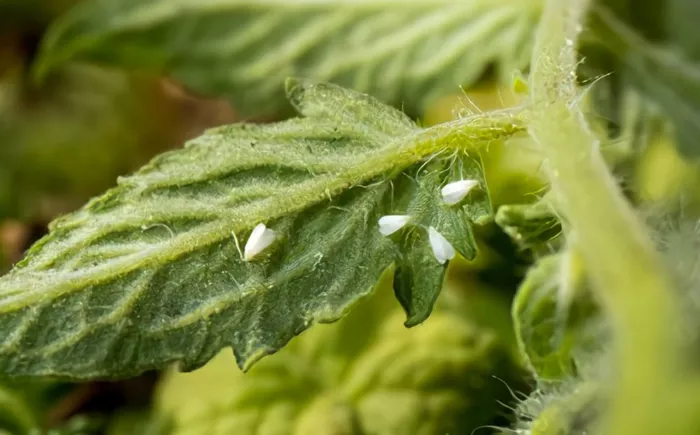Growing tomatoes in your garden can be a joyful and rewarding experience. However, one small pest can cause big trouble—whiteflies. These tiny insects are not only hard to see at first, but they can also damage your tomato plants quickly if not treated. Fortunately, you don’t need harsh chemicals to get rid of them. With natural methods, you can protect your plants and enjoy a healthy harvest.
This guide will help you understand how to spot whiteflies on tomato plants, treat infestations naturally, and prevent them from coming back. All methods are safe for your garden, your family, and the environment.
What Are Whiteflies?
Whiteflies are small, winged insects related to aphids and mealybugs. Despite their name, they are not true flies. They are usually found on the underside of leaves, and they feed on plant sap.
Whiteflies are common pests in home gardens, especially on soft, leafy plants like tomatoes. They thrive in warm, humid climates and can quickly multiply if not controlled.
Why Are Whiteflies Bad for Tomato Plants?
Whiteflies damage tomato plants by sucking the sap, which weakens the plant. As they feed, they also excrete a sticky substance called honeydew. This honeydew attracts ants and leads to sooty mold, a black fungus that blocks sunlight from reaching the leaves.
A severe whitefly infestation can cause:
- Yellowing or curling leaves
- Stunted growth
- Leaf drop
- Reduced tomato yield
How To Spot Whiteflies Early
1. Check the Underside of Leaves
Whiteflies are tiny—only about 1/16 inch long—but easy to identify. When you gently lift the leaves of your tomato plant, you may see small white insects clustered underneath.
2. Look for a Cloud When You Disturb the Plant
If you shake the tomato plant, you may see a cloud of tiny white insects flying up. That’s a clear sign you’re dealing with whiteflies.
3. Watch for Leaf Damage
Whiteflies suck nutrients from the leaves, which can make them yellow, wilt, or curl. If your plant starts to look sick and you see insects underneath, whiteflies may be the cause.
4. Sticky Leaves and Black Mold
If the leaves feel sticky or you notice black mold on them, whiteflies have likely been feeding there for a while. This is a sign of honeydew buildup.
How To Treat Whiteflies on Tomato Plants Naturally
Now that you know how to spot them, let’s talk about how to get rid of whiteflies using safe and natural methods. These techniques are effective and won’t harm beneficial insects, pets, or the environment.
1. Blast Them with Water
Use a garden hose to spray the underside of the leaves where whiteflies hide. This knocks them off the plant and helps reduce their population.
Best time: Morning or evening
Use a gentle but firm spray to avoid damaging leaves
Repeat this every few days until you see fewer whiteflies.
2. Use Insecticidal Soap or Neem Oil
Insecticidal soap and neem oil are both safe for organic gardening and can kill whiteflies on contact.
- Mix the product according to the label
- Spray directly on the underside of leaves
- Reapply every 5–7 days for best results
Neem oil also acts as a repellent and disrupts the life cycle of whiteflies.
3. Introduce Natural Predators
Invite whiteflies’ natural enemies into your garden. These beneficial insects help keep whitefly populations under control.
- Ladybugs
- Lacewings
- Encarsia formosa (a parasitic wasp that targets whiteflies)
You can buy these insects online or from garden centers. Make sure your garden avoids pesticides that may harm them.
4. Set Up Yellow Sticky Traps
Whiteflies are attracted to the color yellow. Sticky traps are a great way to catch adult whiteflies before they lay eggs.
- Place the traps near your tomato plants
- Hang them just above the foliage
- Replace when they get full
These traps also help you monitor the population over time.
5. Prune Heavily Infested Leaves
If certain leaves are badly infested, it’s best to prune and remove them. This reduces the number of eggs and larvae on your plant.
- Use clean, sharp scissors
- Dispose of the leaves away from your garden
- Sanitize your tools afterward
Preventing Whiteflies in the Future
Once you’ve controlled the problem, keep it from coming back with these smart gardening practices.
1. Rotate Crops
Don’t plant tomatoes in the same spot year after year. Rotate with other crops like beans or herbs to break pest cycles.
2. Use Companion Plants
Plant basil, marigold, or nasturtiums near your tomatoes. These plants help repel whiteflies naturally.
3. Keep Your Garden Clean
Remove plant debris and dead leaves regularly. Whiteflies and their eggs can hide in old plant material.
4. Mulch and Water Properly
Healthy plants are less likely to suffer from pests. Use mulch to retain moisture and water consistently to avoid plant stress.
5. Inspect New Plants
Before adding new plants to your garden, check them for pests. Whiteflies often hitch a ride on nursery plants.
FAQs About Whiteflies on Tomato Plants
Q1: Are whiteflies harmful to humans or pets?
No. Whiteflies do not bite or harm humans or animals. They are only harmful to plants.
Q2: Can I use vinegar to kill whiteflies?
Vinegar is not recommended. It can damage your plants. Use neem oil or insecticidal soap instead.
Q3: How long does it take to get rid of whiteflies?
It depends on the infestation. With consistent treatment, you may see improvement in 1–2 weeks.
Conclusion
Whiteflies can be a frustrating pest, especially when they target your beloved tomato plants. But the good news is that natural methods work—and they work well. By spotting whiteflies early and using safe, gentle techniques like neem oil, sticky traps, and natural predators, you can protect your garden and enjoy a rich harvest without relying on chemicals.
With patience and a little effort, your tomato plants can stay green, healthy, and productive—all season long.


